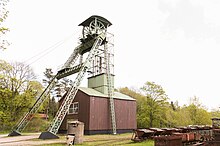Headframe

A headframe
Design
Modern headframes are made of steel, concrete, or a combination of both. Timber headframes are no longer used in
Steel headframes

A steel headframe is less expensive than a concrete headframe; the tallest steel headframe measures 87 m.
A recently erected steel headgear in the Zambian copper belt town of Chililabombwe at the Konkola number 4 shaft has a total height of 81 metres to the top of the maintenance crane rail, with the centre-line of the head sheaves at 71 metres above the collar, making it the highest steel headgear in Africa.
Concrete headframes

Concrete headframes require less maintenance and are less susceptible to corrosion than steel headframes. There is much less waste of concrete during construction of a concrete headframe than there is of steel in construction of a steel headframe. Concrete headframes provide an enclosure upon construction, whereas steel headframes require cladding and insulation to protect from weather. Concrete headframes are less susceptible to vibrations and sway less during high winds. Concrete is usually more readily available than steel (except in remote locations), and the price is predictable, whereas fabricated steel prices can be volatile.[1]
Symbolism
Headframes have become prominent features in historic mining regions. The
In the
In Yellowknife, Canada, the demolition of the Con Mine headframe has met significant public opposition.[5] The headframe was the tallest structure in the Northwest Territories[6] and is regarded by many in the town to be an important symbol of the region's mining heritage.
See also
- Hoist (mining)
- Underground mining
- Barony A Frame
References
- ^ ISBN 0-9687006-1-6. Archived from the originalon 2017-05-04. Retrieved 2008-11-14.
- ^ a b "A Pictorial Walk Through the 20th Century". Archived from the original on 2014-09-06. Retrieved 2008-10-28.
- ^ ISBN 3-87097-145-2
- ^ van Wyngaardt, Megan. "New Gold Fields steel headgear tallest in the world". Mining Weekly. Retrieved 2018-06-09.
- ^ "Yellowknife vote saves Robertson Headframe for now - North - CBC News". Archived from the original on 2013-09-21. Retrieved 2013-11-06.
- ^ "Yellowknife seeks ideas, proposals to preserve mine landmark - North - CBC News". Archived from the original on 2013-09-21. Retrieved 2013-11-06.
